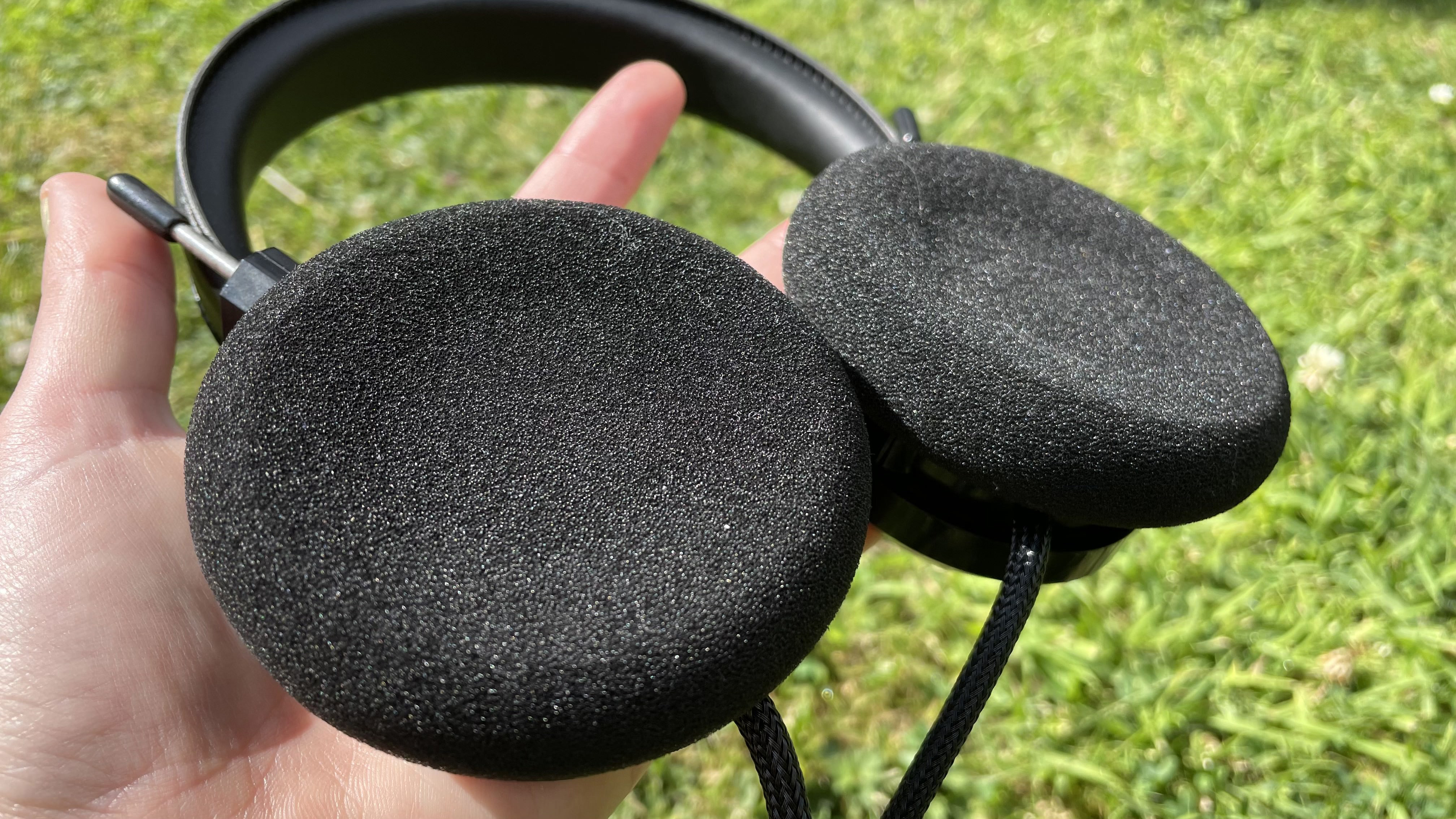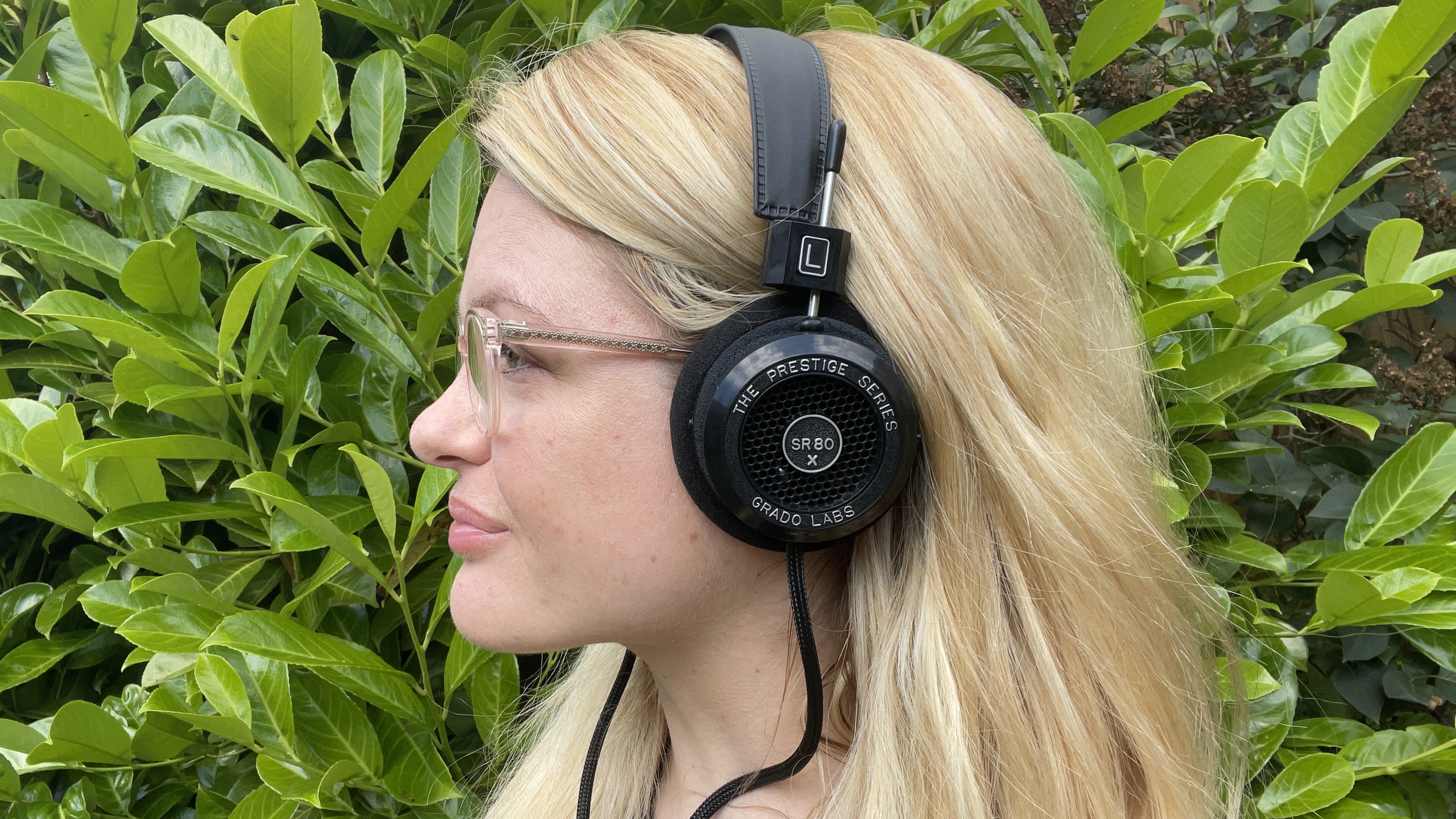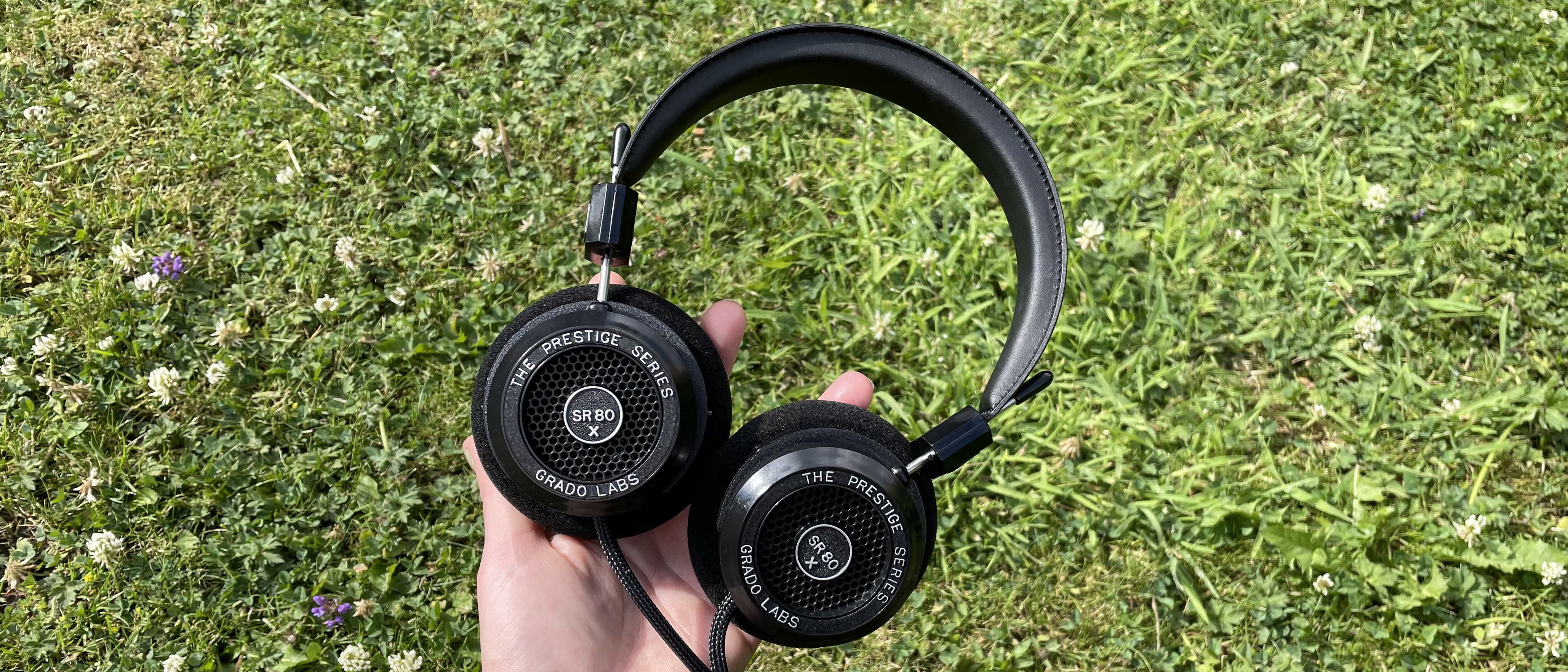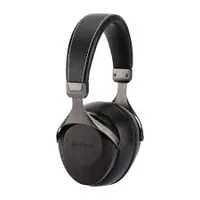TechRadar Verdict
The Grado SR80x Prestige Series headphones are unique. They have a light, comfortable design with a distinctive aesthetic that sits on (rather than over) your ears. Their open-back style means you'll experience sound leakage – be wary where you use them – but they deliver a clear and punchy experience that's a delight to listen to.
Pros
- +
Fantastic sound quality
- +
Light and comfortable to wear
- +
Distinctive, classy design
Cons
- -
Sound leakage
- -
Won't suit all environments
- -
Wired design
Why you can trust TechRadar
The Grado SR80x headphones are the latest version of the brand’s classic (and largely far more expensive) designs. Grado launched the first iteration in 1991 and since then, the Brooklyn-based audio company has been hand-building its products. Regarding where they are in Grado’s range, these SR80x Prestige X headphones succeed the SR80e from Grado’s Prestige E Series and sit below the Reference range. This makes the SR80x the most budget-friendly option after the Grado SR60x.
You’d usually have to pay much more for a pair of audiophile-grade headphones such as these. But Grado has made an excellent package that costs only $125 / £130 / AU$179. Sure, a fair bit is missing if you compare them to the best headphones money can buy (there's no noise cancellation for a start), and you’ll have to accept a more traditional wired connection. But after spending a few weeks with them, they emphatically deserve a place in TechRadar’s best on-ear headphones guide and could even give some of the best over-ear headphones a run for their money.
The Grado SR80x headphones are technically on-ears, although depending on the size of your head and your ears, they could fit over them, just without the same sort of seal you’d expect from the best over-ear headphones. It turns out this shape makes them incredibly comfortable to wear for long periods. Often, on-ears will make my ears feel squashed and my head ache after an hour or so of wear, but I didn’t experience that after four hours of continuous use.

Design-wise, everything about them – how they look as well as how they feel – makes these headphones seem more expensive than they are. They have a relatively simple headband with a silent adjustable slider and super soft padding inside. The cups are constructed from plastic, and the set is gloriously light at just 245g.
They have an aesthetic that we described as brutalist and almost steampunk in our initial hands-on, and I stand by that description. They’re not so distinctive that they look weird when you wear them, but they’re unusual enough that I swooned over them when I first got them out of their box.
A honeycomb-like metal mesh on the earcups emphasizes the open-back design of the Grado SR80x headphones and sound does leak directly from these holes. That’s the other thing that stands out about these headphones; they’re on-ears and have an open-back design, which means there’s sound leakage and whoever is sitting close to you will also hear plenty of what you’re listening to. This is bound to be off-putting to some – especially those who need to work in silence for whatever reason.
The design means there’s also no noise cancellation here. You’ll get some decent passive noise isolation, but it’s nothing to write home about. The Grado SR80x are wired and connect to a device with a long cable over a metre in length with a thick, braided design that makes it easy to grip and feels high-end. You connect it to a device with a 3.5mm headphone jack – so if you plan on using some laptops and most phones, you’ll need an adapter. On that note, I recommend using one of the best portable DACs to level up the power and audio quality if you use a laptop or phone as a source device – and the splendid Fiio BTR7 will give you a wireless option too.

I wouldn’t blame you for thinking the Grado SR80x headphones seem like a confusing proposition. Can you handle stepping back to a wired connection? Will sound leakage be too annoying at work? But these Grado headphones are worth it. To clarify, they prove their aforementioned worth when it comes to their all-important sound quality.
There’s no ANC, which means you won’t experience an immersive cocoon of sound. But they are packed with 44m dynamic drivers to offer a balanced, clear and detailed sound. It's a performance that'll make you enjoy using them for days on end. I was desperate to listen to my favorite tracks with them and noticed new details and levels of precision every time.
Sign up for breaking news, reviews, opinion, top tech deals, and more.
I didn’t experience the power or booming bass I’d have expected from a pair of headphones offering a better seal or ANC – again, these are open-back headphones – but high treble frequencies shine. When listening to The Dead Weather’s Horehound, the instrumental passages, cymbals and vocals were incredibly entertaining and three-dimensional – the sort of high-end audio quality often described as studio sound.
It has been mentioned above, but it bears repeating the Grado SR80x Prestige Series headphones are unique. They look different to many competitors but are incredibly light and comfortable. They offer an open-back design with a fair modicum of sound leakage, but the trade off for that minor inconvenience is excellent audio quality. And both myself and my colleagues do mean excellent.
Of course, if you don’t like the idea of sound leakage or getting used to a pair of wired headphones again, these aren’t for you. But if you’re looking for affordable headphones that sound sensational and feel very good, consider the Grado SR80x headphones. If you can handle those minor inconveniences, you will not regret it.
Grado SR80x: Price & release date

- Launched in early May 2021
- $125 / £130 / AU$179
The Grado SR80x headphones were released in May 2021 and cost $125 / £130 / AU$179.
Because we've stressed these on-ear headphones are a unique proposition, it's tricky to weigh them up against the competition. Having said that, you can find good pairs of on-ears for a little cheaper than these Grados, including the Jabra Elite 45h and Sennheiser HD 250BT, both at nearly half the price.
However, the Grado SR80x headphones are still affordable in our book, especially given the excellent sound quality, which will please audiophiles more than the competition. (Quite a bit more, in fact.)
Grado SR80x: Specs
| Drivers | 44mm dynamic |
| Active noise cancellation | No |
| Weight | 240g |
| Connectivity | Wired, 3.5mm headphone jack |
| Frequency range | 20Hz - 20kHz |
| Waterproofing | No |
Should you buy the Grado SR80x?
| Features | There are no features to write home about here, it's all about the comfort and sound quality. | 3 / 5 |
| Sound quality | Clear, detailed sound that's a bit treble heavy but highly enjoyable. Just be prepared for leakage. | 4 / 5 |
| Design | Light, comfortable and distinctive. These headphones look fantastic. | 4 / 5 |
| Value | There are cheaper on-ears, but not that deliver such quality sound and an all-day wear sort of experience. | 4 / 5 |
Buy them if...
You want a clear, detailed sound
These Grado headphones provide a really enjoyable sound that puts clarity and precision above all else.
You're happy with an on-ear design
They're the most comfortable on-ears you'll try. If you're not keen on the suction of in-ears or the bulk of over-ears, they're a good middle ground.
You want no-frills headphones
There are no fancy features here, just good sound that plugs into your source device. If you're a minimalist, you'll be happy.
Don't buy them if...
You need to work in a quiet environment
Sound leakage is unavoidable here, so if you need ultimate silence, these aren't for you.
You want noise cancellation
There's decent noise isolation here, but if you want the immersive experience of ANC, look elsewhere.
You don't like wires
These are wired headphones, so if the flexibility of Bluetooth or true wireless appeals, these aren't for you.
Grado SR80x: Also consider
| Grado SR80x | Sivga Robin | Audio-Technica ATH-M50X | |
|---|---|---|---|
| Price | $125 / £130 / AU$179 | $149 / £149 / AU$269 | $150 / £113 / AU$199 |
| Drivers | 44mm dynamic | 50mm dynamic | 45mm dynamic |
| Active noise cancellation | No | No | No |
| Weight | 240g | 275g | 285g |
| Connectivity | Wired, 3.5mm headphone jack | Wired, 3.5mm headphone jack | Wired, 3.5mm headphone jack |
| Frequency range | 20Hz - 20kHz | 20Hz - 20kHz | 15Hz - 28kHz |
Sivga Robin
A similar proposition to the Grado SR80x but with a slightly sleeker-looking, wooden design. If you don't mind wired headphones without ANC but want bigger earcups check out the Sivga Robin.
Read our full Sivga Robin review
Audio-Technica ATH-M50X
For a similar price you can get these Audio-Technica DJ headphones with a lively and engaging sound. They're also wired but offer excellent sound for under $200/£200.
Read our full Audio-Technica ATH-M50X review
How I tested the Grado SR80x

- I spent two weeks testing the Grado SR80x headphones
- I tested them at home, while walking through the city, on public transport and working in a local coffee shop
- I plugged them into an iPhone 13 Pro via a USB-C-to-3.5mm adapter for most of my testing but also trialled them with an Astell & Kern A&norma SR25 MKII
I tested the Grado SR80x headphones for just over two weeks in a range of environments. While walking through central London, on the tube, on the train, working in a busy coffee shop, and then on a few breezy walks along the Yorkshire coast.
I thoroughly enjoyed using them in all of these scenarios. However, it's hard to say where you would be able to use the Grado SR80x headphones because it's a totally subjective experience. Some people (hi!) may not care that everyone around them can hear what they're listening to a little bit.
Others who are more private about their choice of tunes or work in a mostly silent space (I'm so sorry) aren't likely to enjoy taking them out in public. That doesn't mean you won't enjoy listening at home, but it's worth considering before you buy them.
I've been reviewing consumer tech for more than 12 years now, focusing mainly on the gadgets we all wear – think headphones, fitness tech and VR headsets. I'm really passionate about helping readers choose the devices that'll work best for them – not necessarily the ones with the high-end specs or big marketing budgets behind them.
First reviewed June 2023

Becca is a contributor to TechRadar, a freelance journalist and author. She’s been writing about consumer tech and popular science for more than ten years, covering all kinds of topics, including why robots have eyes and whether we’ll experience the overview effect one day. She’s particularly interested in VR/AR, wearables, digital health, space tech and chatting to experts and academics about the future. She’s contributed to TechRadar, T3, Wired, New Scientist, The Guardian, Inverse and many more. Her first book, Screen Time, came out in January 2021 with Bonnier Books. She loves science-fiction, brutalist architecture, and spending too much time floating through space in virtual reality.


